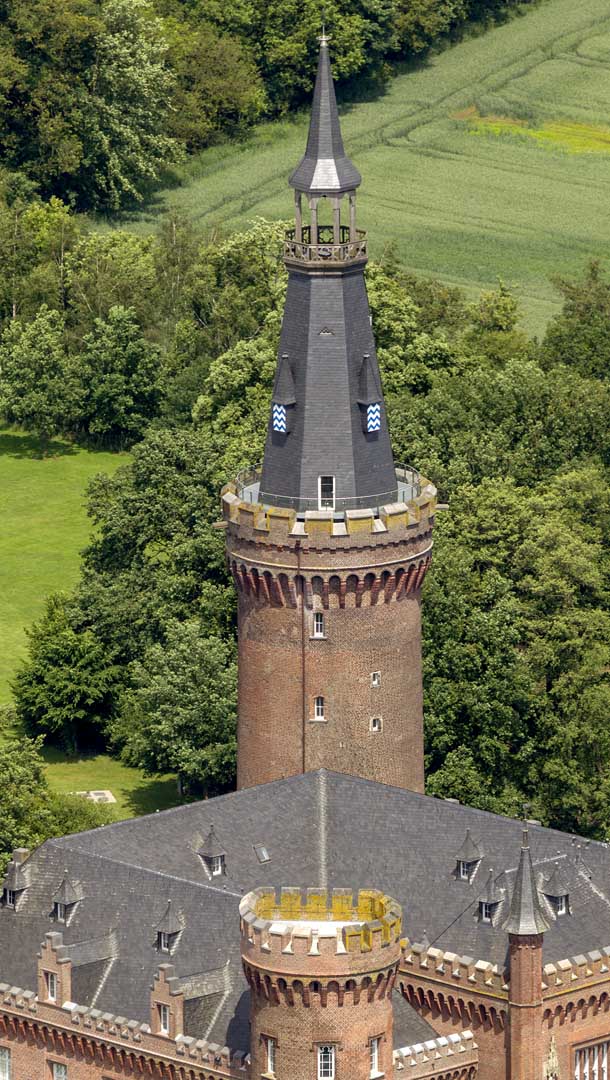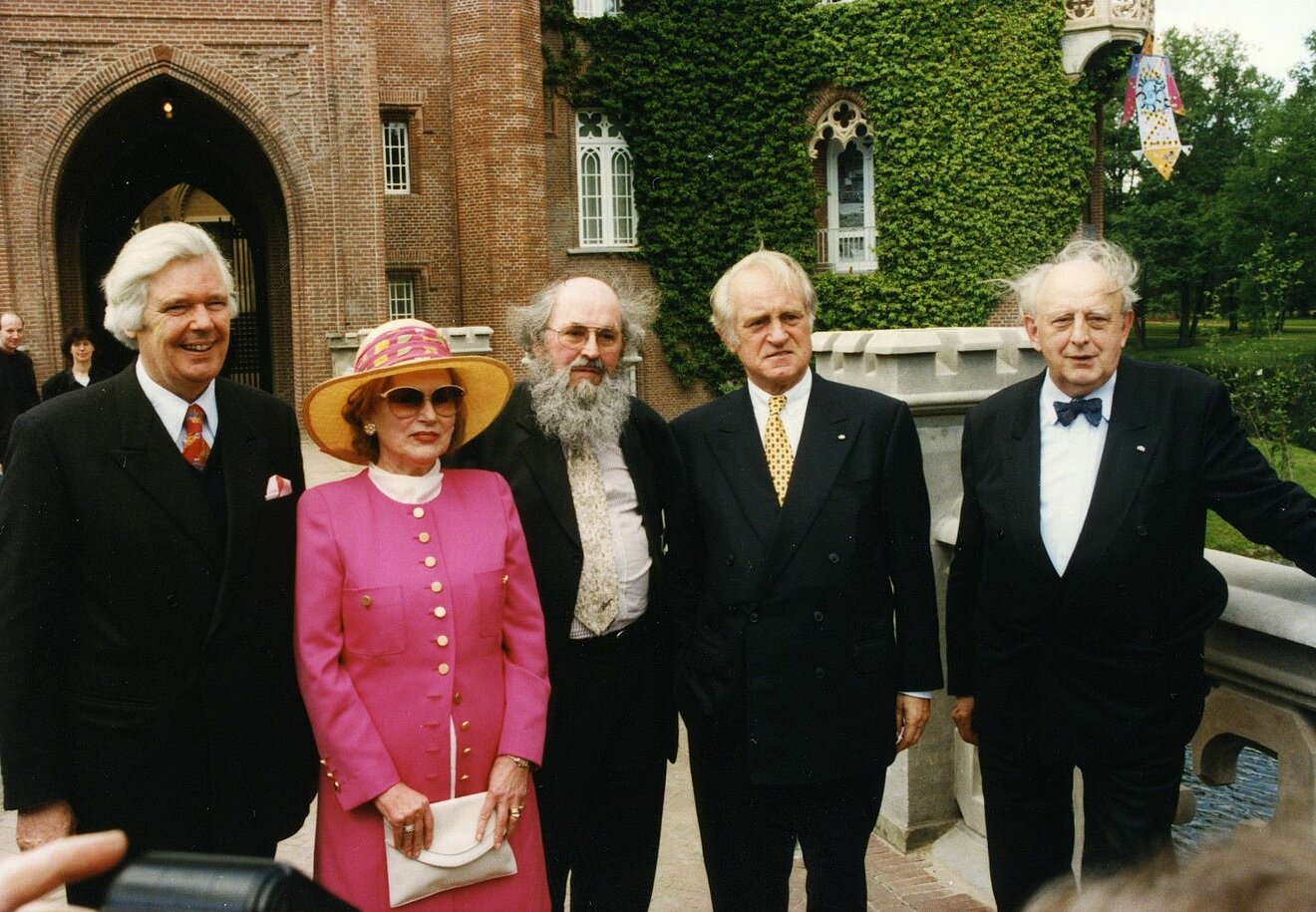The history of Moyland Castle begins in the early 14th century. Over the subsequent centuries, the medieval moated castle was remodelled many times. A significant change in the complex took place in the baroque period. In the 19th century, the master builder of Cologne Cathedral Ernst Friedrich Zwirner reconstructed the castle in the neo-gothic style. Until 1945, the von Steengracht family, who had bought the estate in 1766, used the castle as their residence. Following severe damages during the end of the Second World War, the building remained a ruin for decades. After the founding of the Museum Schloss Moyland Foundation in 1990, the reconstruction of the castle and restoration of the garden complex began, according to their last historically documented state.
As a result of severe war damage, all the original furnishings and historic rooms were completely lost. The interior was subsequently refurbished for use as a museum. The Museum Schloss Moyland was opened in May 1997.
Moyland in the Middle Ages
The first Moyland ‘castle’ was a foursided fortified edifice, surrounded by a moat and defence walls, with three horseshoe-shaped corner towers and a fortified, inhabitable keep. Its construction is recorded in a document dated 1365. During the late Middle Ages, three two-storey residential wings with an imposing great hall were built abutting the defence walls and the castle chapel in the east tower was built. Because the castle was inherited through the female line, the aristocratic families at Moyland changed frequently. ‘Moyland’ never became the name of a dynasty. It denotes the castle and the adjoining land.
Moyland under the lords von Bronckhorst und Batenburg
From 1542 to 1662 the family von Bronckhorst and Batenburg were the lords of Moyland. Their ancestral seat was Anholt Castle near Isselburg. Inventories from the 16th and 17th centuries shed light on how the rooms at Moyland were used: There were chapels, the great hall, rooms for women, men and servants, functional rooms such as the kitchen, laundry and a cellar for brewing, and storage rooms. The burgrave, judge and administrator for the lords of the castle, resided there, as did the clerk. Further, stables, granaries, a smokehouse, a smithy and a guardhouse are mentioned.
Moyland under the family van Spaen
Alexander van Spaen was, next to the governor Johann Moritz von Nassau-Siegen, the most important man in the Brandenburg government in Cleves in the second half of the 17th century. He maintained close contact with the Great Elector Friedrich Wilhelm von Brandenburg. Due to his good connections with the Dutch, he acted as a middleman between the Great Elector and the House of Orange. In 1662 van Spaen underpinned his social ambitions by purchasing Moyland. His son Friedrich Wilhelm van Spaen had to sell Moyland to the Brandenburg elector and sovereign of Cleves, Friedrich III, in 1695.
The Baroque Refurbishment of the Medieval Castle and Its Surroundings
Alexander van Spaen had Moyland converted into a prestigious summer residence by an unknown, probably Dutch master builder. The upper floors and roofs were raised, the towers were given spires and the north tower a round cupola with an open lantern. A large staircase was built inside, and the ‘Great Hall’ was added on the upper floor, which, like the other castle rooms, was furnished in the baroque style following the Dutch model. In front of the castle, two baileys were built, connected by a gatehouse. The redesign of the park with its avenues radiating into the landscape also goes back to van Spaen.
Moyland under the Brandenburg electors and Prussian kings in the 18th century
Friedrich III, since 1701 King Friedrich I in Prussia, seldom visited Moyland. Administrators took care of the castle and adjoining lands. An inventory of 1700 provides information about the refurbishment of that time. In contrast, Friedrich‘s son King Wilhelm I did not invest much in Moyland, which already began to become run down in the first half of the 18th century. At that time the royal domain included 18 farms and 33 small cottages, in which approximately 250 people lived. In the mid-19th century, tobacco was grown and mulberry trees were planted to breed silk worms.
Friedrich the Great and Voltaire
The first personal encounter between the young Prussian king Friedrich II (1712–1786) and the French writer and philosopher François Marie Arouet, known as Voltaire (1694–1778), took place in Moyland Castle from 11 to 14 September 1740. During a ‘nocturnal dinner’ the king, his companion and the philosopher discussed at length the immortality of the soul and freedom. Voltaire, a prominent advocate of the Enlightenment, tirelessly opposed irrationality, religious fanaticism and intolerance. As early as 1736 Friedrich and Voltaire initiated a correspondence that was to last 42 years.
Moyland under the family Steengracht in the 18th and 19th centuries
Adriaan Steengracht, who lent money to Friedrich II during the Seven Years‘ War, acquired Moyland Castle and its territory called Herrlichkeit (splendour) as well as a (largely damaged) inventory worth 102,000 Dutch gilders. He had Moyland repaired and took over the lands and their jurisdiction. Adriaan Steengracht stayed at Moyland regularly. In the 19th century Moyland once again flourished when Johan Steengracht van Oostcapelle provided it with a valuable art collection, open to the public, and made Moyland a popular tourist destination.
Neo-Gothic reconstruction of the castle
The reconstruction carried out by the architect of Cologne Cathedral Ernst Friedrich Zwirner under Nicolaas Johan Steengracht van Duivenvoorde consisted mainly of the following measures: The entire building was refaced in brick, the fenestration made uniform and the towers raised. Battlements around the whole castle and windows with tracery were added. In the middle of the main façade a risalit with slender corner towers, statues of knights, a portico and a hall in the upper storey were constructed. A high spire with a lantern crowned the north tower.
The former interior of Moyland Castle
Photographs and postcards of the interior before the castle was destroyed clearly show that many of the Baroque furnishings were still in place in the 20th century. Apparently Zwirner did not plan to redecorate the rooms in neo-Gothic style. The Steengracht art collection was housed in the ‘Gallery’ (‘Great Hall’) and the ‘Small Gallery’ (the former ‘Courtroom’). In guidebooks of the late 19th and early 20th centuries, the park, castle and collection were recommended as attractive destinations for excursions.
Moyland Castle, destroyed after 1945
Moyland Castle and its outbuildings were severely damaged during heavy frontline battles between the German, British and Canadian troops in early 1945. From February 1945, the castle was occupied by allied soldiers. Subsequently, soldiers and civilians plundered Moyland Castle. Most of the interior furnishings, art and porcelain collection and library have been missing since that time. The initial measures to secure the castle ruins were largely undone by a serious fire in 1956.
Reconstruction
The precondition for rebuilding was a new use for the castle. The first plans for a museum to house the van der Grinten Collection date back to 1964, were revived in 1984, when Joseph Beuys was still alive, and became concrete in 1986. Under the direction of the Kranenburg architect Karl Ebbers, the debris began to be cleared away in 1987. The exterior was restored to the state of Zwirner‘s neo-Gothic reconstruction. In order to serve as a museum, the interior was restructured into galleries, cabinets and halls, which reflect the historic layout of rooms. The high roof framework was subdivided to create an additional storey.
The historic garden complex
In the second half of the 19th century the former Baroque garden was redesigned in the so-called mixed style. Elements of the English landscape garden were combined with the geometric patterns of architectonic gardens. After the war the garden went to seed. Rose and Gustav Wörner, landscape architects from Wuppertal, were responsible for restoring the historic garden complex to the state it had enjoyed in the late 19th and early 20th century. Inspired by a book of herbs from the late 15th century, which used to belong to Moyland, an herb garden was added in 1999. A sculpture park, established in 1997, enhances the ensemble.
The founding parties and sponsors of the Museum Schloss Moyland
Now the art collection donated by the brothers Hans and Franz Joseph van der Grinten is on exhibition in the reconstructed Moyland Castle, which the family von Steengracht contributed to the Foundation. The state of North Rhine-Westphalia financed most of the costs of construction and has carried the major part of the yearly operational costs since that time. The Museum Schloss Moyland also receives regular financial support from the region Cleves, the community of Bedburg-Hau and the Society of Friends of the Museum Schloss Moyland.
North tower
The spire on the north tower goes back to the redesign of the castle complex in the mid-19th by the master builder of the Cologne Cathedral at the time, Ernst Friedrich Zwirner. With the high tower construction, Zwirner undoubtedly aimed to emphasise the historical function of the castle keep, the importance of this architectural element which once served as last refuge in case of hostile threat. With this, he also created the characteristic variegated, asymmetrical silhouette of the castle.
Zwirner gave the then still medieval castle the appearance which was then reconstructed in the 1980s and 90s. The restoration of Zwirner’s castle design was, however, initially incomplete without the spire on the north tower. In 2008, this gap was closed with the help of the state of North Rhine-Westphalia and the Society of Friends of the Museum Schloss Moyland. Since then, the nearly 30-meter-high neo-Gothic spire on the north tower of the castle has once again become the emblem of Moyland.
From its observation platform, you can enjoy a fascinating view of the surrounding Lower Rhine landscape – in clear weather even as far as the Netherlands.
Gallery

Foto: Stiftung Museum Schloss Moyland/Hans Blossey

Foto: Stiftung Museum Schloss Moyland/Hans Blossey

Foto: Stiftung Museum Schloss Moyland/Hans Blossey

Foto: Stiftung Museum Schloss Moyland/Axel Jusseit

Foto: Stiftung Museum Schloss Moyland/Hans Blossey
Foto: Stiftung Museum Schloss Moyland/Maurice Dorren

Foto: Stiftung Museum Schloss Moyland/Axel Jusseit
Foto: Stiftung Museum Schloss Moyland/Maurice Dorren









